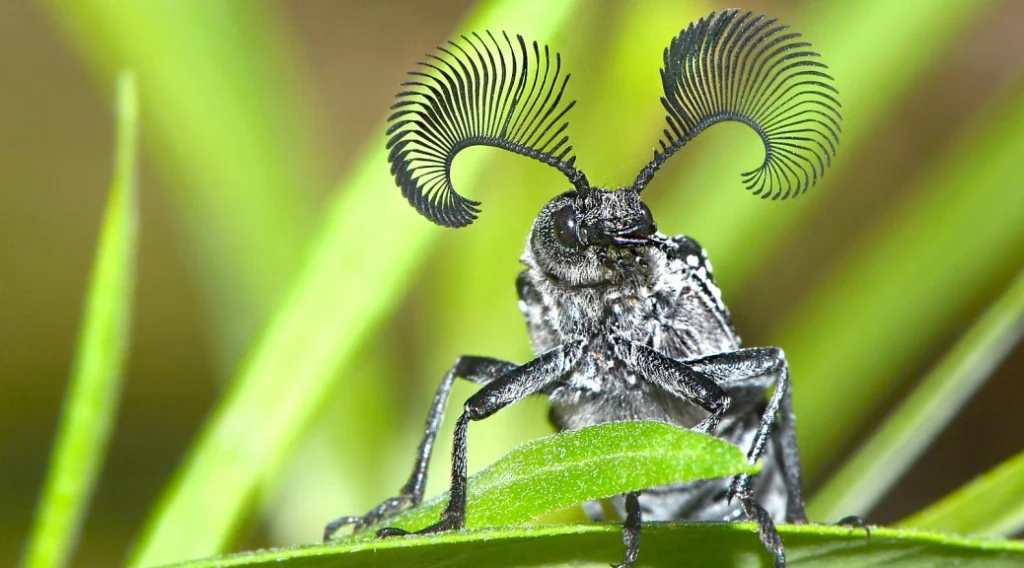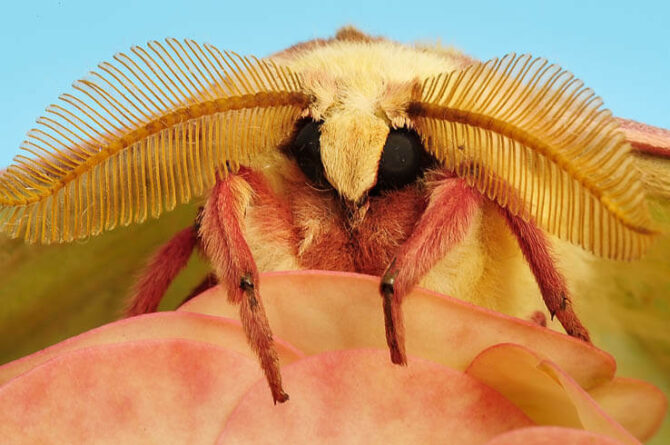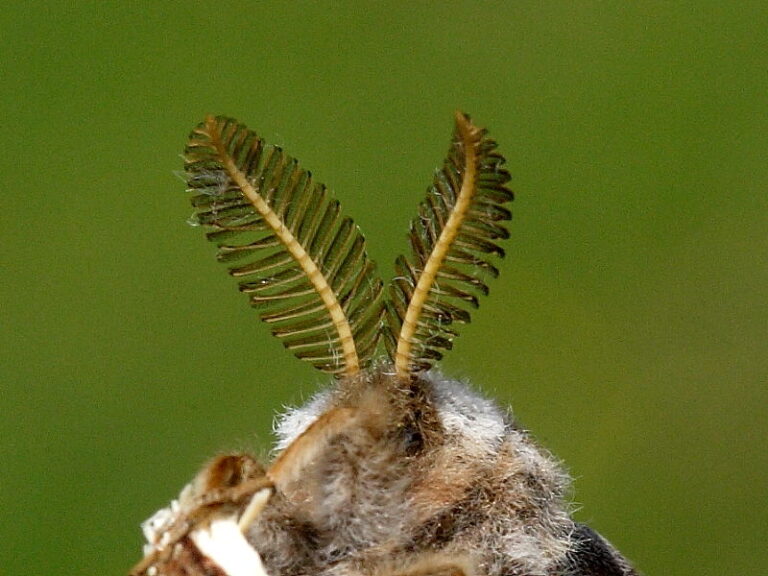Yes, moths do have antennae. Antennae are sensory appendages located on the heads of insects, and they serve various functions, including the detection of chemical signals (pheromones), sensing their environment, and helping with navigation. Moths typically have two long, slender antennae that protrude from their heads.
Moreover, these antennae play a crucial role in helping moths locate mates, find food sources, and avoid predators. The size, shape, and structure of moth antennae can vary among different moth species and can be adapted to their specific ecological needs.
How is a moth’s body structured?
When examining the anatomy of moths, it’s essential to understand their overall body structure, which is characterized by the following features:
Moths, like all insects, have a segmented body consisting of three main parts: the head, thorax, and abdomen. These segments are highly specialized for various functions.
In addition, moths have an exoskeleton, a rigid outer covering made of chitin. This exoskeleton provides support and protection, but it also restricts their growth.
To accommodate growth, moths undergo molting, shedding their old exoskeleton and developing a new one.
Moths, like all insects, possess six jointed legs. These legs are attached to the thorax and are primarily used for walking and grasping objects.
Focus on the Head and Sensory Organs

The head of a moth is a crucial part of its anatomy, housing several sensory organs and vital structures:
As the main topic of this discussion, the antennae are the prominent sensory appendages on the head of moths.
Moreover, they consist of multiple segments and are covered in sensory hairs or sensilla. These sensilla are sensitive to chemical cues, vibrations, and other environmental signals.
In addition, moths typically have large, compound eyes composed of numerous tiny visual units called ommatidia. These eyes provide moths with a wide field of vision and are especially well-suited for detecting movement and changes in light intensity.
Furthermore, the proboscis is a long, flexible tube-like structure that moths use for feeding. It is adapted for siphoning nectar from flowers, and in some cases, for piercing fruits to access their juices.
Moths have paired structures called palps located near their mouthparts. These palps are involved in sensing and manipulating food, and they can be quite diverse in shape and function among different moth species.
In addition to the antennae, moths often have specialized olfactory organs in their heads. These organs help moths detect and respond to pheromones released by potential mates and to chemical cues from their environment, such as the scent of flowers or the presence of predators.
What is the role of antennae in insect biology?
Antennae are highly specialized sensory appendages found on the heads of insects, including moths. These structures are rich in sensory receptors and serve as vital tools for insects to perceive and interact with their environment. Here, we’ll delve into a deeper understanding of antennae as sensory appendages:
Insect antennae are typically elongated, slender structures that vary in size and shape among species.
Moreover, they are composed of multiple segments, often referred to as flagellomeres, which can range from a few to many segments, depending on the insect.
Antennae are covered in microscopic sensory structures called sensilla. These sensilla come in various types, each specialized for detecting specific sensory cues such as chemicals, temperature, humidity, and mechanical stimuli.
For example, chemosensory sensilla are involved in detecting pheromones, food odors, or environmental chemicals.
Within the sensilla, there are sensory receptor cells that convert sensory stimuli into electrical signals. These signals are then transmitted to the insect’s nervous system, allowing it to interpret and respond to its surroundings.
Role of Antennae in Insect Biology:
The antennae in insects play a multitude of critical roles in their daily lives and survival. Let’s explore these roles in more detail:
In many insect species, antennae are crucial for detecting chemical signals, including pheromones. Pheromones are chemical cues used for communication between individuals of the same species.
For example, moths use their antennae to locate potential mates by detecting sex pheromones released by females.
Insects use their antennae to locate and assess potential food sources. They can detect the scent of flowers, fruits, or decaying organic matter, helping them find suitable places to feed. Antennae also assist in probing and sampling potential food items.
Antennae are sensitive to environmental factors such as temperature, humidity, and air currents.
Furthermore, this sensitivity helps insects navigate and adapt to their surroundings. For instance, some insects can detect changes in air pressure and use this information to anticipate weather changes.
Insects, including moths, rely on their antennae to navigate through complex environments. They can detect chemical cues left behind by other individuals or use the direction of odor gradients to find their way to specific locations.
Antennae can also play a role in detecting potential threats, including predators or hazards. Insects may use their antennae to detect vibrations or airborne cues associated with danger, helping them initiate defensive behaviors or escape.
How do moth antennae vary among different species?
Moth antennae are specialized sensory structures found on the heads of moths. These antennae are essential for various aspects of their biology, including finding mates, locating food, and navigating their environment. Here, we will provide a detailed description of moth antennae:
Moth antennae are typically long and filamentous, consisting of a series of segments called flagellomeres. The number of flagellomeres can vary among moth species, ranging from a few to many segments.
The surface of moth antennae is covered in tiny sensory structures called sensilla. These sensilla come in different types, each specialized for detecting specific types of sensory information.
For example, chemosensory sensilla are responsible for detecting chemicals like pheromones and food odors, while mechanosensory sensilla can detect vibrations and air currents.
In many moth species, there is sexual dimorphism in antennal structure, meaning that males and females have different antenna shapes or sizes. This dimorphism is often related to their roles in finding and attracting mates.
Male moths may have more elaborate or feather-like antennae, which are highly sensitive to female pheromones, allowing them to locate potential mates from a distance.
Variations in Antennal Structure Among Moth Species
Moths belong to a diverse group of insects, and as a result, there can be significant variations in antennal structure among different moth species. These variations are often related to their specific ecological niches and behaviors. Here are some insights into the diversity of moth antennae:
Moths that rely heavily on pheromones for mating often have specialized antennae. These antennae are designed to detect even trace amounts of pheromones, ensuring the moth can locate a mate efficiently.
Furthermore, the structure of these antennae can vary greatly among species, with some having highly branched and feathery antennae for increased sensitivity.
Some moth species have adapted their antennae for feeding. For example, the long-tongued hawkmoths have elongated proboscises, which are essentially extended mouthparts that allow them to reach deep into flowers for nectar. These moths may have relatively shorter antennae compared to their body size.
Moth antennal shape and size can vary from species to species. Some moths have slender and thread-like antennae, while others may have more clubbed or swollen antennae.
In addition, the specific shape and size can be influenced by factors like habitat, diet, and ecological niche.
Moths that are active at night (nocturnal) may have different antennal adaptations compared to those active during the day (diurnal).
Nocturnal moths may have antennae that are highly sensitive to low light conditions and can help them navigate in the dark.
Moths that have specialized relationships with certain host plants may have antennae adapted to detect specific chemical cues emitted by those plants. This helps them locate suitable places to lay their eggs or find nectar sources.
How do moth antennae aid in navigation and survival?

Moth antennae are particularly well-suited for detecting pheromones, which are chemical compounds released by moths and other insects for communication, primarily in the context of mating. Here’s a deeper understanding of how moth antennae are involved in pheromone detection:
Moth antennae are equipped with specialized sensilla, primarily pheromone receptors, which can detect minuscule quantities of pheromone molecules in the air. This extreme sensitivity enables male moths to locate female moths from considerable distances.
Furthermore, different moth species produce unique blends of pheromones. Male moths have antennae that are finely tuned to detect the specific pheromones released by females of their own species. This specificity ensures successful mating between conspecifics.
Male moths use their antennae to follow the pheromone plume, which is a concentration gradient of pheromone molecules carried by the wind.
By moving upwind or downwind along this plume, male moths can pinpoint the location of a female moth and ultimately find her for mating.
Sensing the Environment:
Moth antennae serve as versatile sensory organs that help moths gather information about their environment:
Sensilla on the antennae can detect changes in temperature and humidity. This information is essential for moths to adapt their behavior and activity levels to environmental conditions. For example, they may become more active when conditions are favorable for flight.
Antennae can sense air currents and turbulence. This ability is crucial for moths, as it helps them navigate and maintain stable flight. Sensing air movement allows them to avoid obstacles and stay on course.
In addition to pheromones, moths can detect other chemical cues in their environment using their antennae. They can sense the odor of flowers to locate nectar sources, detect chemical signals from predators or competitors, and assess the suitability of potential oviposition sites for laying eggs.
Navigation and Survival
Moth antennae play a vital role in the navigation and overall survival of these insects:
Moths rely on their antennae to orient themselves in their environment. By detecting specific environmental cues, such as the scent of their host plants or landmarks, they can navigate to preferred locations for feeding and reproduction.
Furthermore, moths use their antennae to detect vibrations and chemical cues that may indicate the presence of predators or other threats. This early warning system helps them take evasive action and avoid becoming prey.
Antennae assist moths in locating essential resources like food and suitable breeding sites. For example, they can detect the odor of nectar-producing flowers or chemical cues indicating the presence of appropriate host plants for their larvae.
Nocturnal Navigation: In the case of nocturnal moths, antennae are especially important for navigating in low-light conditions. They rely on their antennae to detect and follow scent trails, making them adept at nighttime navigation.
FAQ’s
What are the antennae of a moth?
Moth antennae are slender, segmented structures on the moth’s head, covered in sensory hairs or sensilla.
Do butterflies have antennae?
Yes, butterflies also have antennae; they are similar in structure to moth antennae.
Do moths and butterflies have antennae that signal?
Yes, both moths and butterflies use their antennae for signaling, primarily in detecting pheromones for mating.
Why are moth antennae so sensitive?
Moth antennae are sensitive because they contain specialized sensilla that can detect even tiny amounts of pheromones, helping moths find mates.
What are two insects that have antennae?
Two insects with antennae are bees and ants.
How many butterfly antennas?
Butterflies typically have two antennae, one on each side of their head.
What are the antennae of insects?
Antennae in insects are sensory appendages on the head used for detecting environmental cues such as chemicals, temperature, and air currents.
Final Thought
In conclusion, we’ve explored the world of moth antennae. These little feelers play a big role in a moth’s life. They help moths in many ways, like finding mates, knowing what’s around them, and staying safe. Moth antennae are flexible tools that work well in different places where moths live.
Also, the many different types of antennae among moth species show how important they are for survival. Understanding moth antennae helps us see how nature equips even small creatures to do well in their homes.

